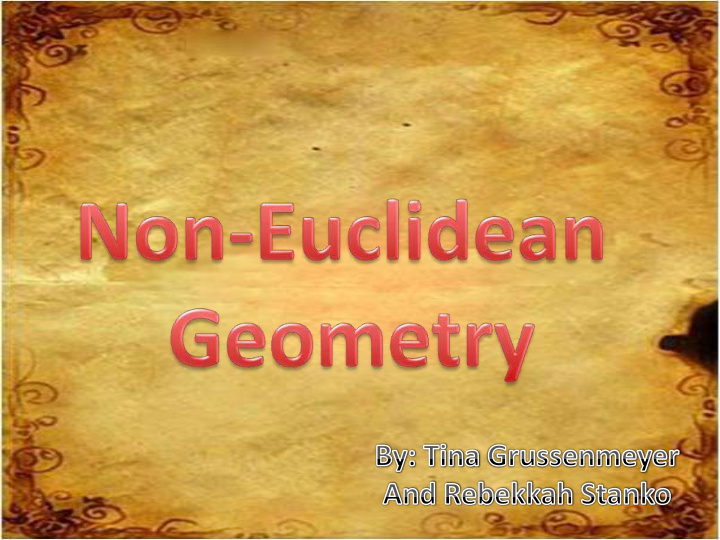



What makes geometry Euclidean or Non-Euclidean?
I-1. Each two distinct points determine a line I-2. Three noncollinear points determine a plane The 5 Axioms of I-3. If two points lie in a plane, then any line containing those two points lies in that plane Euclidean Geometry I-4. It two distinct planes met, their intersection is a line I-5 If a straight line falling on two straight lines makes the sum of the interior angles on the same side less than two right angles, then the two straight lines, if extended indefinitely, meet on that side on which the angle sum is less than the two right angles.
The Most Controversial The Parallel Postulate: In layman’s terms * Given a line and a point not on that line, there is exactly one line through the point that is parallel to the line. p m
Why is it Controversial? • Many felt the parallel postulate was a theorem and Euclid was just not clever enough to prove • For two thousand years, people tried to deduce the fifth postulate from the other four • Were they successful?
*400 AD Proclus *1616-1703: John Wallis The Road of Controversy *1667-1733: Saccheri *1786: Posthumanous *19 th century: abandoned efforts
Proclus assumed that points at constant distance from a given line on one side form a straight line
John Wallis assumed to every triangle, there is a given triangle of each given size
Saccheri considered quadrilaterals with base angles equal to a right angle and vertical sides having equal length deduced the possibility that the remaining two angles were not right angles
Posthumanous publication of Lambert’s work which was similar to that of Saccheri Lambert noticed that, in this new geometry, the angle sum of a triangle increased as the area of the triangle decreased.
*19 th century: abandoned efforts to find a contradiction to the fifth postulate
Different Types of Non-Euclidean Geometry
Creation of hyperbolic geometry *2000 years were spent trying to prove the 5 th postulate Hyperbolic *Started to wonder could a system of plane geometry be created with more than one line parallel to a given line *Gauss never published his work *Bolyai constructed the foundations of hyperbolic geometry *Lobachevsky first to publish his results of a hyperbolic geometry
*Saddle *Hyperbolic paraboloid Hyperbolic points and lines through any two points in hyperbolic space there is a line *A point which passes through the center is a Euclidean segment, Ie diameter What does hyperbolic geometry look like? Properties of hyperbolic lines 1. Two distinct hyperbolic lines meet at most once 2. Two distinct hyperbolic lines may have one common boundary point (along the perimeter of Poincaré disc) Parallels 1. Two hyperbolic lines do one of the following -Intersecting: intersect at one point -Parallel: Share a common boundary point -ultra parallel: neither intersect nor share a boundary point
Example: Poincare disc *Lines are arcs of circles *Two arcs that do not meet are parallel *Two arcs that meet orthogonally are perpendicular (I don’t understand what this means but maybe you do?) *Can see in the works of Escher
Also known as spherical geometry or Riemannian geometry Elliptic/Spherical Treats lines as great circles on the surface of a sphere In elliptical geometry, Euclid's parallel postulate is broken because no line is parallel to any other line. Parallel lines? In spherical geometry any two great circles always intersect at exactly two points.
Example: shortest flying distance from Florida Application of to the Philippine Islands is a path across Alaska Elliptical Geometry Even though the Philippines are at a more southerly latitude than Florida! The reason is that Florida, Alaska, and the Philippines lie on the same great circle and so are collinear in spherical geometry.
Still not convinced? Try This!
• In elliptic geometry, the sum of angles of a triangle is >180 The Effects of Non-Euclidean Geometry on Triangles
References • http://mathworld.wolfram.com/Non-EuclideanGeometry.html • http://www.learner.org/courses/mathilluminated/images/units/8/1812.png • http://www.daviddarling.info/encyclopedia/E/elliptical_geometry.html • http://www.answers.com/topic/elliptic-geometry-1 • http://www.gap-system.org/~history/PrintHT/Non-Euclidean_geometry.html
Recommend
More recommend